Seed and Plant Identification
of Vegetables and Gardening Seed
Seed and Plant Identification is an important part of growing vegetables. When they first germinate, they usually have seed leaves. It can be difficult to tell the difference between your garden vegetables and weeds at this point.
This page of images relates to the seed leaves and true leaves as well as gardening seed you are likely to have questions about in growing vegetables.
Lettuce
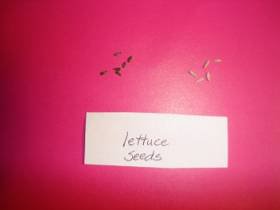


Bibb, Boston,and Buttercrunch type lettuce has round smooth baby leaves when it emerges. The true leaves are longer and a bit more oval but still smooth-edged. These types of lettuce are very tender and almost melt in your mouth.
They prefer cool weather, and do best in early spring or late fall. They do not tolerate hot, dry, sunny conditions well. Lettuce prefers slightly acid soil, so if yours is very acid you can add some dolomite.
Sow the tiny seeds in rows and thin to 5 inches apart or plant 4 per square foot. Plant them 1/8"-1/4" deep, just lightly covered with soil. The photos will help with seed and plant identification if you lose track.
Generally they will germinate within 10 days or so. They will grow to form loose heads with a buttery texture. Keep the soil consistently moist. If the soil dries out it can cause bolting, as can hot weather. Bolting means that a stalk will grow in the center of the head and make flowers and seeds. This turns the lettuce leaves bitter.
Young Bibb lettuce leaves in photo to the left.
Black Seeded Simpson lettuce leaves in photo above.
Black Seeded Simpson, Oak Leaf, and other leaf lettuce varieties form very loose leaf heads of generally ruffled leaves and various colors. Loose leaf is the easiest type of lettuce to grow, and is very reliable until the weather gets hot.
If you are short on space, loose leaf lettuce can be harvested by picking the largest outer leaves of each head while leaving the remainder of the plant to continue growing.
In this way you conserve space and time, as it will have leaves ready for harvesting most of the time. Once the weather gets hot, however, most varieties tend to send up a stalk which flowers and makes seed.
Lettuce is self pollinated, and will not cross with other varieties, so you can have different varieties growing in your garden to make splendid mixed salads in spring and early summer. Then, once they bolt, you can still save the seeds of open pollinated types.
There are a few cultivars or varieties that take heat better, and if you live in an area where summers don't go much over 90 degrees, and you can give the plants partial shade, you can probably keep lettuce growing through the summer.
If you want to have some fall lettuce, it is best to start plants in the house in a pot. Put the pot in a south facing window or use a grow light. You can then plant the young seedlings after 4-6 weeks, in your garden for a fall crop around September 1st. They will tolerate a light frost, so you can still grow lettuce until the first hard frost.
Romaine is also a loosely headed variety, with long narrow leaves. The culture for romaine is the same as leaf lettuce.
Head lettuce, like iceberg, requires long, cool springs to develop proper heads. This is the standard lettuce in the grocery store.
Okra


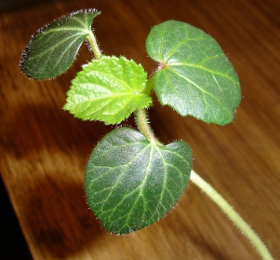
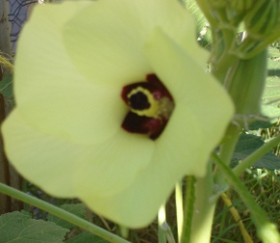
 Okra is one of those vegetables that you either love or hate. If you've never tried it, consider giving it a chance. I myself gradually acquired a taste for it by my husband coaxing me to try a small piece of his fried okra from the serving at Church's fried chicken. At first I wrinkled my nose at the unfamiliar taste.
Okra is one of those vegetables that you either love or hate. If you've never tried it, consider giving it a chance. I myself gradually acquired a taste for it by my husband coaxing me to try a small piece of his fried okra from the serving at Church's fried chicken. At first I wrinkled my nose at the unfamiliar taste. The mucilaginous liquid inside of okra is somewhat unusual. It looks like snot, and feels like snot. Fortunately, it doesn't taste that way. It is really quite tasty when it's fried, like mushrooms or zuchinni.
It also has some interesting health properties. It is full of nutrients, works like psyllium in the digestive tract by keeping you regular, and is said to help control blood sugar.
Another way that I really enjoy okra is pickled. Walmart carries Texas brand pickled okra, give it a try. The taste is somewhere between pickles and olives.
Traditionally it is used in Gumbo and Brunwick Stew. That mucilaginous liquid mentioned earlier has thickening properties. We've used it to stick the breading on in place of milk. I've used it to substitute for egg in a few recipes as well.
Okra likes heat, and will do well when other vegetables are sulking and panting. It produces big flowers that bloom for a day, and then become a pod. These pods should be picked daily when they are 3 inches long, or they will get woody. Use a light pruning shear and wear long sleeves, as the plants can irritate skin with their spines. Clemson Spineless is open pollinated and my favorite. They will stop producing if not picked daily.
The large round seeds should be planted 1/2 " deep, and about 18" apart. These get to be large plants, especially in warm climates. The pods, once harvested, can be blanched for 2 minutes and then frozen whole. They will keep in the freezer for 12 months. You can also slice and bread them with cornmeal and salt before freezing, then just deep fry them when you want to enjoy some.
Be adventurous, give them a try. I did, and now enjoy them even raw.
The plants come up with 2 rounded, nearly heart shaped leaves. The somewhat hairy first leaves are smooth edged, but as you can see above, they become serrated with the true leaves. Above are photos of a bloom and some pods from last year's garden.
Onions

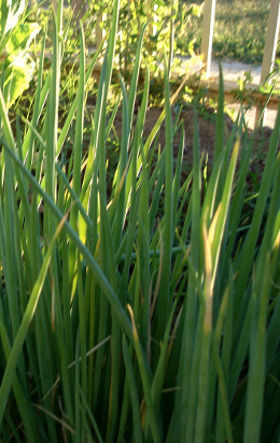
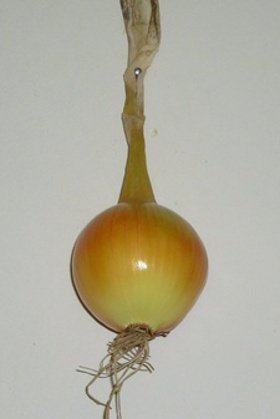
Green onions are seeded into the garden in early spring. The seeds should be planted about 1/8 inch deep, 4 seeds per inch.They are easy to grow, requiring average soil and moisture, but good drainage is essential. They grow quickly, and you can sow more rows 2 weeks apart if you just want green onions.
If you want full size onions, then start your onions indoors in a pot about 12 weeks before your last frost date. You will need to harden them off by gradually exposing them to outside conditions. Start with 2 hours, and add an hour per day for the first week. The second week keep them outside for 10-12 hours per day, then plant in the garden.
Set them 4 inches apart, just barely in the soil.
This will give them enough time to get to full size. They are ready to harvest when at least 1/3 of the top falls over. If you plan to store them, 1/2 of the top has to have fallen over. After harvesting, let them cure in a dry, airy, place for 2 weeks. Then hang them in net bags,in a cool dry place, below 39 degrees but above freezing. Onions start sprouting at 40 degrees.
If any of the onions send up a stalk to make seeds, pull it and use it. They won't store after going to seed. If you want seed then you can leave it until the seed is ripe. It forms at the top of the plant.
Onions are edible at all stages, so you can choose to use them or store them.
I hope the photos will help you with seed and plant identification of your garden vegetables. I don't have a photo of the seedling green onions, but they look like a blade of grass at first, and then just like the bigger version above.
Parsley
 Parsley seed is rather small, and it can help to mix a small amount of sand or dirt with the seed, and make sure the seed is evenly dispersed in it, before dropping it into the rows.
Parsley seed is rather small, and it can help to mix a small amount of sand or dirt with the seed, and make sure the seed is evenly dispersed in it, before dropping it into the rows.
It can take anywhere from 4 to 6 weeks before the seedlings pop up out of the soil, so don't despair if it isn't up as quickly as other seeds.
A cool weather plant, it can take light frost. As early as the ground can be worked, plant the seeds in rows. The rows should be at least 6 inches apart. The root type (Hamburg parsely) will grow much like a carrot. It is a great addition to soups, high in minerals.
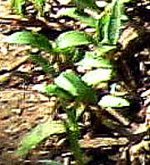
The root type (Hamburg parsley, shown in the rows to the left) will grow much like a carrot. It is a great addition to soups, high in minerals. It can be used as soon as the roots are a few inches long and 1/4 inch thick. I use the small plants pulled during thinning in soup.
 For leaf types, you will need the rows a little farther apart. It can be harvested any time before it bolts and goes to seed in the second year. Like carrots, it will send up a center stalk that is like an umbrella. The small white flowers will go from green to the ripe color you see above.
For leaf types, you will need the rows a little farther apart. It can be harvested any time before it bolts and goes to seed in the second year. Like carrots, it will send up a center stalk that is like an umbrella. The small white flowers will go from green to the ripe color you see above.
The seed should dry on the stalk at least until over half of the seeds have changed color.
There are straight leaf and curled leaf varieties in the leaf only type. These will do well in a pot, and you can just harvest the outer leaves as needed, while leaving the center to continue growing until a hard frost.
A pot can be brought into the house over the winter, and in less than bright light conditions, should wait to bolt until spring.
from Seed and Plant Identification back to Veg. Plant Identification
from Seed and Plant Identification back to Vegetable Gardening Advice Home
to Seedling and Plant Identification-4